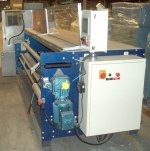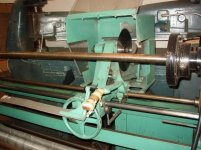Jason H
Stainless
- Joined
- Mar 29, 2006
- Location
- Los Angeles, CA.
Team PM,
I have a new project that I would like to start that seems easy enough. I have found photos of a machine that would fit my need, but I don't know who made it and I don't know how I could just go buy one, so I need to build it. These photos came from an auction site that already sold the machine. Tell me what I am seeing here.
What are the components that are being used, what type of HMI is recommended? Any ways to improve on this that you can see. Please point me in the right direction.
The purpose of this machine is to cut rolls of fabric while it is still on the tube. The roll is made perfectly straight on another machine that rewinds it, which I have no problem building.
I have a new project that I would like to start that seems easy enough. I have found photos of a machine that would fit my need, but I don't know who made it and I don't know how I could just go buy one, so I need to build it. These photos came from an auction site that already sold the machine. Tell me what I am seeing here.
What are the components that are being used, what type of HMI is recommended? Any ways to improve on this that you can see. Please point me in the right direction.
The purpose of this machine is to cut rolls of fabric while it is still on the tube. The roll is made perfectly straight on another machine that rewinds it, which I have no problem building.


















